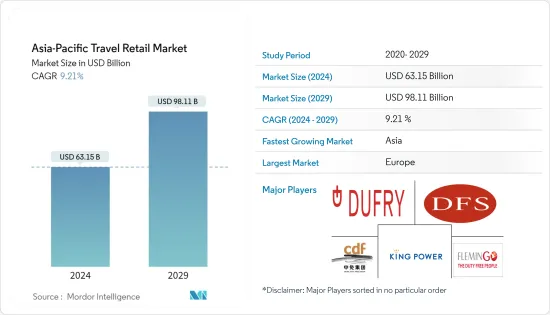PUBLISHER: Mordor Intelligence | PRODUCT CODE: 1537670

PUBLISHER: Mordor Intelligence | PRODUCT CODE: 1537670
Asia-Pacific Travel Retail - Market Share Analysis, Industry Trends & Statistics, Growth Forecasts (2024 - 2029)
The Asia-Pacific Travel Retail Market size is estimated at USD 63.15 billion in 2024, and is expected to reach USD 98.11 billion by 2029, growing at a CAGR of 9.21% during the forecast period (2024-2029).

The growing income of the middle-class population increased the development of the travel retail market in Asia Pacific. Asia Pacific is the home of some of the world's most popular countries and a tourist destination. The region's tourism sector is increasing due to the rise in domestic and international travelers. The Asia Pacific region offers attractive duty-free shopping incentives that allow travelers to make tax-free purchases, so these factors attract more travelers to the Asia Pacific region and, therefore, fuel the growth of the travel retail market.
The primary factor that drives the travel retail business in Asia-Pacific is the increasing tourism because foreign investors visit and do tax-free shopping. Many marketers are establishing themselves in Asian marketplaces. One of the largest importers of cosmetics and clothing is in the region, contributing to expanding the Asia-Pacific market. Hence, the region's travel retail market generates revenue through fashion, accessories, fragrances, cosmetics, wine, and spirits.
Due to the increased adoption of premium lifestyles, the luxury product market in the region is growing. Factors like an increase in disposable income, extensive social media usage, and increased urbanization increase investments in personal luxury goods, which fuels the expansion of the travel retail market in the Asia Pacific region.
APAC Travel Retail Market Trends
High Revenue Generation From Airport Retailing Drives The Market
The primary factor driving the travel retail market in the Asia-Pacific region is the increasing growth of the tourism sector. Many foreign investors visit countries like Hong Kong and Malaysia for tax-free shopping. The airport became a vital retail channel for brands to promote and create product awareness among customers. Airports are branching out the business to segments like retail, restaurant bars, and cafeterias. 60% of commercial income gained by the airport owners is through airport retail and commercial services, including food and beverage. It contributes to direct investments in Asia-Pacific's aviation infrastructure and increases the development of the Asia-Pacific retail market.
China Dominates The Market
The travel retail industry in China is growing due to the rising demand for tourism, luxury goods, and cosmetics. Apart from this, the industry is getting massive support from the government in Hainan province to boost industry growth. Due to the benefits gained from globalization and steady traffic growth, the travel retail market became attractive in China. To achieve the government's aim of developing a special economic zone or a tourist destination in Hainan, china brought overseas consumption back to its domestic market. Thus, China dominates the travel retail market in the Asia-Pacific region.
APAC Travel Retail Industry Overview
The Asia-Pacific travel retail market is fragmented. The companies are grabbing new contracts and entering into new markets with the help of technological advancements and product innovations. The major brands are opening exclusive stores for unique products. The companies are promoting and selling limited editions to increase their visibility and brand awareness in the market. The major market players are Dufry, DFS Group, China Duty-free Group Co. Ltd, King Power, and Flemingo International.
Additional Benefits:
- The market estimate (ME) sheet in Excel format
- 3 months of analyst support
TABLE OF CONTENTS
1 INTRODUCTION
- 1.1 Study Assumptions and Study Deliverables
- 1.2 Scope of the Study
2 RESEARCH METHODOLOGY
3 EXECUTIVE SUMMARY
4 MARKET INSIGHTS AND DYNAMICS
- 4.1 Market Overview
- 4.2 Market Drivers
- 4.2.1 Guaranteed Customer Base In Travel Duty-Free Shops Drives The Market
- 4.2.2 Exemption From Taxes When Goods Are Taken Out Of The Country Of Purchase Drives The Market
- 4.3 Market Restraints
- 4.3.1 Security Concerns Like Heightened Security Measures And Restrictions At Airports And Other Travel Hubs
- 4.3.2 Market Oppurtunities
- 4.3.2.1 E-commerce Integration
- 4.3.2.2 Exclusive Product Launches
- 4.4 Value Chain / Supply Chain Analysis
- 4.5 Porters 5 Force Analysis
- 4.5.1 Threat of New Entrants
- 4.5.2 Bargaining Power of Buyers/Consumers
- 4.5.3 Bargaining Power of Suppliers
- 4.5.4 Threat of Substitute Products
- 4.5.5 Intensity of Competitive Rivalry
- 4.6 Insights on Technology Innovation In The Market.
- 4.7 Impact of Covid 19 On Market
5 MARKET SEGMENTATION
- 5.1 By Product Type
- 5.1.1 Fashion and Accessories
- 5.1.2 Jewellery and Watches
- 5.1.3 Wine & Spirits
- 5.1.4 Food & Confectionary
- 5.1.5 Fragnances and Cosmetics
- 5.1.6 Tobacco
- 5.2 By Distribution Channel
- 5.2.1 Airports
- 5.2.2 Airlines
- 5.2.3 Ferries
- 5.3 By Geography
- 5.3.1 China
- 5.3.2 Japan
- 5.3.3 Korea
- 5.3.4 India
- 5.3.5 Australia
- 5.3.6 Southeast Asia
- 5.3.7 Rest Of APAC
6 COMPETITIVE LANDSCAPE
- 6.1 Company Profiles
- 6.1.1 Dufry
- 6.1.2 China duty free group co., ltd.
- 6.1.3 DFS Group
- 6.1.4 King Power
- 6.1.5 Heinemann Asia Pacific
- 6.1.6 Lotte Duty Free
- 6.1.7 The shilla duty free
- 6.1.8 Flemingo International
- 6.1.9 James Richardson Group
- 6.1.10 The Nuance Group*
7 MARKET FUTURE TRENDS
8 DISCLAIMER AND ABOUT US




